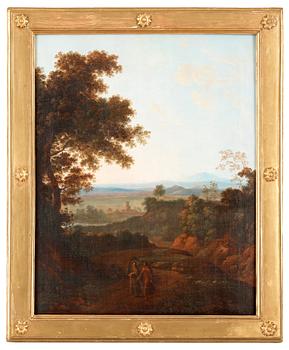Pierre-Henri de Valenciennes, väitetty
An Italian landscape with Franciscan monks
Oil on canvas 62.5 x 49.5 cm. In a late eighteenth century Italian ornamented gilt frame
Muut tiedot
Like many French artists of the 1700s, Pierre-Henri de Valenciennes was drawn to Rome. After studying painting in his hometown of Toulouse, Valenciennes visited Italy's capital in 1769 and spent much of the next two decades there. For the most part, he ignored the well-known monuments and panoramas, favoring humble vistas and ruins. He was not alone in this pursuit, but whereas other French artists generally sketched these modest subjects, Valenciennes painted oil studies in the out-of-doors.
Returning to Paris in 1785, Valenciennes quickly established his reputation at the Salon as a painter of paysage historique (historical landscapes inspired by mythology and Greek antiquity). These paintings, representing imaginary visions of the classical past, earned Valenciennes the title, "the David of landscape." In 1800, in an effort to raise the status of landscape painting, he published an ambitious and influential treatise, Elémens de perspective pratique .

































